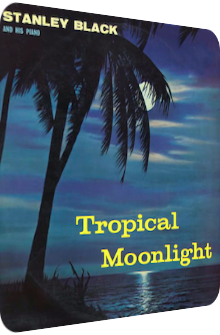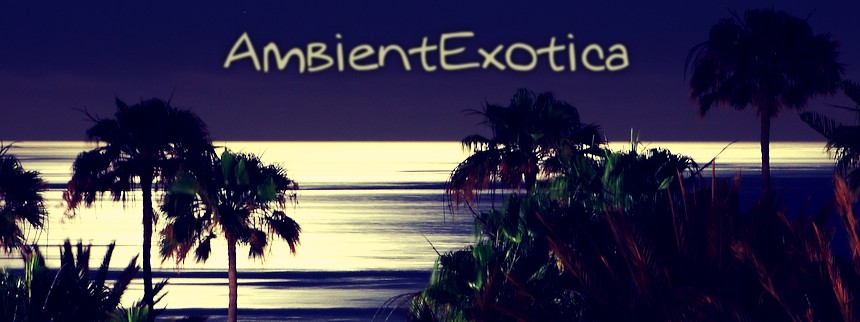
Stanley Black
Tropical Moonlight
1957
British multi-talent Stanley Black (1913–2002) is to this day one of the most prolific Exotica conductors and pianists. There, I said it. The problem is: this assertion is not necessarily true. It all depends on each listener's definition of the genre called Exotica. Exotic Percussion of 1961 remains Black's vivaciously texturized symphonic pinnacle, whereas the piano-driven Cuban Moonlight of 1958 is his dull monotonous misstep. The latter has a counterpart. A gorgeous foil. Tropical Moonlight is released on Decca Records in 1957 when the first humble creations of the melting pot called Exotica were works in progress. Stanley Black gathers a small unmentioned Latin combo around him on this release, presenting 14 wonderfully varied pieces – eleven of them dreamy, three of them dance-oriented and one original track written by Black himself – that all refer back to the moon-lit front cover which is indeed a truthful depiction of the music. The aura of the tropics and nightly beach sceneries are definitely perceptible in each track, and one can really sense that the combo is up for it.
What goes horribly wrong on the later Cuban Moonlight works all the better on Tropical Moonlight for two major reasons: firstly, the instrumental pool is decidedly widened. Stanley Black's piano is in the limelight, but splendidly – and regularly! – accompanied by glockenspiels, gossamer double bass strings, acoustic guitar twangs and a few exotic percussion instruments, namely bongos, congas, claves and maracas. The variety and versatility of the arrangements is secondly mirrored in the chosen song material. Tropical tunes are included, sure thing, but there are lots of perfectly commonplace Pop standards of the 40's and 50's which are aptly exotified. Don't expect birdcalls or overly esoteric instruments from far-away places, for Tropical Moonlight's roots are in the classic Jazz soil. The tropical moods are solely created via the dreamy interplay and entanglement of the instruments. Please read on and see why Tropical Moonlight puts the ashen Cuban Moonlight to shame.
Tropical Moonlight opens with an instant classic and an early foreshadowing artifact of the Exotica movement: Morton Gould’s Tropical – envisioned in 1948 as a piano piece as it is common today, but then transformed into a fully fleshed-out orchestra piece – is taken back to its roots with Stanley Black on the piano. The polyphony of the tercets are nocturnal and perfectly humid, with the additional glockenspiel and the aqueous Latin percussion injecting doses of esprit and uplifting moods. It is a pitch-perfect beginning of this LP and inherits the then latest Hawaiian fashion of loosened piano arrangements. The Kiss In Your Eyes follows. Originally written by Richard Heuberger and part of the operetta Der Opernball from 1898, it is Bing Crosby’s take of the musical film The Emperor Waltz from 1948 that eventually causes its inclusion on Stanley Black’s album. The dark rhythm melody on the piano is underwhelming, but the sparkling chords and the laid-back clicks of the claves boost the dreaminess and successfully point to the gradual nascency of the young Exotica genre.
While Nacio Herb Brown’s and Gordon Clifford’s Paradise is a blatant copy of the former arrangement due to Black’s meticulous attempt to maintain the moon-lit atmosphere and deviating the listener from noticing that he or she actually listened to two different tracks, it is Louis Guglielmi’s 1950 song Cherry Pink And Apple Blossom White which changes the aura from moony to a positively coruscating chime- and glockenspiel-infused staccato piano piece. The sudden cowbells and incessant use of the drums make it surprisingly dynamic in the given context. The main melody on the piano might be sun-soaked and bright, but the other band members aptly place the afternoon atmosphere into the night.
Louis Wolfe Gilbert’s Two Silhouettes offers the next surprise: delicately clicking claves, a whisper-quiet acoustic guitar and double bass accents augment the phantasmagoria of this lush rendition, and Ernesto de Curtis’ Come Back To Sorrento is equally dreamy once it is stripped off its clichéd accordion baseframe in this incarnation; the claves are clicking again, Black’s deliberately easygoing and accessibly slow piano chords elongate the otherwise mercurial melody. An excellent version! Black ends side A with Angelo Apolonio’s Turista, the most effervescent and Latinized tune of the whole album with gorgeously euphonious chords, Brazilian shakers and frantic bongos. Was this song really recorded in the same session? It is bubbling and spluttering!
Side B opens with Raul Ferrão’s famous April In Portugal and pre-empts Stanley Black’s later counterpart LP Cuban Moonlight, although this tune is densely layered with monotonous acoustic guitar backings, fizzling maracas and iridescent piano droplets; it would not have been featured with the same arrangement-related features on the much more reduced Cuban foil. La Vie En Rose by composers Marguerite Monnot and Louis Guglielmi follows next and is indeed tropified by Black thanks to the clave aorta and the transfiguring piano chords. The silent backdrop is particularly noteworthy on this piece, for it expands the moony aura and frees the arrangement from the many dangerous kitsch traps this evergreen can cause in suboptimal settings. Black’s take works well and eliminates any trace of cliché.
While his take on Arthur Benjamin’s Jamaican Rumba is exciting but ultimately failing due to the creepy, all too frosty entanglement of the high-region piano tones and the adjacent glockenspiels which prevent the magic to unfold, Alexander Borodin’s, George Forrest’s and Robert Wright’s Stranger In Paradise is a return to form, with the claves making a return in an otherwise strongly piano-focused piece. The enchanting soothingness and poeticized wondrousness is injected into each single note.
Atlantide (Sands Of Time) comes from Stanley Black’s own feather and harks back to the hectic blitheness of Turista. Warm jumpy piano chords play next to wonderfully hollow and omnipresent bongos and glistening shakers. The melody itself is not overly memorable, but the percussion layers compensate this little flaw with ease. The tempo itself is the biggest selling point and intersects through the dreaminess in a tasteful way. Auguste Richepin’s Mon Coeur Est Un Violon brings back the languorous aura with the most entrancing glockenspiel-related interplay between glissando and staccato of the whole LP. The dark piano is in constant dialog with this device, and it is here that the piano is inferior to another instrument for the first and definitely last time, as it is the carrying element in the closing track Neja Do Cabelo Duro by David Nasser and Rubens Soares despite the most uplifting inclusion of the acoustic guitar and the tropical percussion instruments. Stanley Black ends Tropical Moonlight with another celebratory, upbeat concoction that boosts the tropical heat of the night.
Stanley Black’s Tropical Moonlight is a wonderful album for those people who want strong tropical flavors and atmospheres in their music, but are not necessarily all too fond of the never-ending flood of man-made birdcalls or ever-shifting instruments. The compositions are the actual stars on this LP, the arrangements themselves are pretty basic and never too far off or spacey. And yet does Stanley Black open the gates when he intermixes a larger amount of instruments that are nowhere to be found on the follow-up Cuban Moonlight, at least not in these generous amounts; glockenspiels, claves, maracas, bongos, these devices do not only refer back to the tropical prospects as set by the title and front artwork, but aurally transform the moonlight and weave it into the soundscape as well. Cuban Moonlight is not only far more limited in its instrumental pool, it is naturally narrowed down to a specific theme: despite the same amount of 14 songs, they are all related to Cuba. There is nothing wrong with this focus, but the allusion and synesthetic taste of the term Tropical allow a broader range of compositions to be featured, even ones that are perfectly rooted in Western Jazz realms such as La Vie En Rose or Cherry Pink And Apple Blossom White.
The – humble and less glaring – tropification of these tunes is an important side venue with the added boon of stripping the well-known clichés off these tunes. Eleven out of the 14 tracks offer perfectly laid-back, easygoing and balmy moon-lit scenarios, with three compositions being delightfully fast-paced and humid. While Tropical Moonlight does not reach the grandeur and pompousness of Stanley Black’s symphonic Exotica apex Exotic Percussion, it is the pianist’s next best thing when it is time to worship the exotic realms. The album is luckily available as a digital download at Amazon MP3 or iTunes, but alas, it is often coupled with the less than stellar Cuban Moonlight. Perversely enough, during the publishing date of this review, it is Cuban Moonlight that is separately available in several editions. Tropical Moonlight remains in it bundled state with its bad brother. But enough complaints. Tropical Moonlight is simply delicate and a great entry into the night-themed Exotica list of releases.
Exotica Review 173: Stanley Black – Tropical Moonlight (1957). Originally published on Jan. 26, 2013 at AmbientExotica.com.
